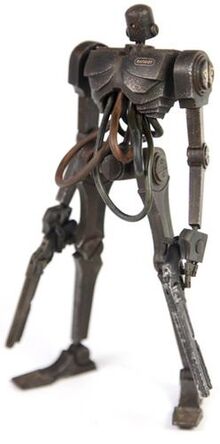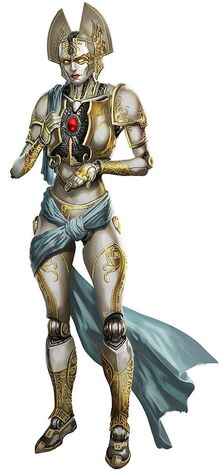"Sick of your life? Ready for a change? Sell off your unnecessary body and become a neurodonor! Dogs don't have worries, why should you?"
"Neurdonors" is the collective name for anyone who donates their body, but retains their central nervous system. Their CNS is placed into the robotic body of an animal, anything with four legs really. Dragons, centaurs, and pegasi aren't possible because the brain power required to power six limbs is beyond human concentration.
Limitations[]
- The body must be at least the size of a human brain
- The body can only have four limbs
- It's irreversible
The Process[]
A human brain & its brain stem is removed from the donor's body. An animal body, or sometimes a human body, is built. The brain is then placed into the neurodonor body, and the limb controls are attached to the brain stem. The body is then shut, and the neurodonor is alive.
Most neurodonors are combustion powered, with impulses from the brain controlling the engines which power each leg. There are some newer models that use solar power and electric engines.
It is not reversible. There is no way to go back to an organic human body. You can go to a robotic human body (called an android), but you cannot go back to an organic human body.
While you can move between robotic bodies, the process takes a while and is dangerous. Most people only swap bodies when they want to upgrade.
Value of a Human Body[]
The amount that your body sells for depends on a huge number of factors. Anything that can affect your health, affects how much your body sells for. However, the rice of neurodonors means there's many more organs on the market than there were.
Models and Cost[]


There are certain neurodonor models which are mass-produced, and quite cheap. The wolf to the right is an example of a cheap, mass-produced model. Most of the mass-produced models are combustion-powered, made of steel, and have a very clock-work appearance.
The wolf image below that one is of a higher-cost model; this one is more likely electric, which makes it much quieter and efficient than the cheaper models.
All models have some similarities; they can all talk and understand human languages as they did in life. Most lack the ability to write, as they aren't able to hold pencils, but they can still speak.
They also have a special reinforced case for their brain, to protect it from all damage. Neurodonors are frequently more active and violent than humans, and need more protection around their brains to prevent them from getting a concussion.
Neurodonors, being robots, have some advantages over organics. Some can hear on the radio frequency, allowing them to speak silently to one another. Others can see in the dark. Most neurodonors are stronger and faster than they were as humans.
Engines[]
All neurodonors have to be powered in some way. The cheapest models use a single internal combustion engine to power their legs, and a single electric engine to change internal gears. The most expensive models use multiple internal electric engines, as they're quieter and produce no exhaust.
Power[]
Combustion neurodonors use fuel to power their engines, much the same as cars. They can use that engine to power any internal electrical engines they have. Fully electric models need to plug in and recharge occasionally, depending on the size of their batteries.
Identification[]
All neurodonors that lack hands have a unique sigil on the underside of their chin. This is used in place of a signature, to stamp official documents. The sigil can be anything; from a unique curly shape to a full-blown heraldic crest. It's just generally used in place of a signature, fingerprint, or other indentifying material. Some neurodonors will have their sigil covered most of the time, only exposed when they want to sign something, to prevent identity theft.
Most Popular Animals[]
- Wolves / Large Dogs
- Horses / Deer
- Big Cats
- Large Birds
Human Neurodonors (Androids)[]


Some people opt to move from their human body, to a robotic human body. These people are called androids, to distinguish them from other neurodonors who choose to become animals.
The model on the right on top is a cheaper, mass produced model. It's made of steel and is nowhere close to passing as human.
The model on the right on bottom is a much more expensive, custom model. Androids generally have much more detail, and while some attempt to model humans as closely as they can, others embrace their robotic heritage and simply try to be walking works of art.
Android bodies are universally more expensive than neurodonor bodies, as they require more detail in their production and aren't usually mass produced. They're also fairly large, and simple require more materials. As well, it's difficult to power a human body with a single motor, and most require multiple.
Advantages[]
Android bodies are generally much faster and stronger than organic human bodies. They do not need food or water, only fuel, which is generally much less expensive.
They don't need to sleep. Some androids with electric engines need to recharge, which is essentially sleeping, but only takes around an hour or two as opposed to eight. Combustion engine androids do not need to sleep.
Disadvantages[]
You lose a significant amount of dexterity when you move to a robotic body, unless you've purchased a very expensive model.
You're loud. Electric engines are quieter than combustion engines, but most neurodonors and androids use internal combustion engines. Additionally, combustion engines produce CO2 exhuast, which can be very dangerous in enclosed spaces with other humans.
Distrust. This is elaborated on in the societal perception section.
Lifespan[]
I'm basing this on the study that braincells can outlive the body. As long as a brain does not have a neurodegenerative disease, it can live to around 200 years old. Any damage, such as concussions or cancers, will irreversibly shorten that length.
Living Conditions[]
Depending on the material that their bodies are made of, some neurodonors are more resistant to weathering than others. The mass produced models, made of steel, will rust over time and must get regular maintenance. The expensive ones, made of stainless steel, kevlar, or glass, are much more resistant and can sleep outside. Depending on which animal they are, it may be easier to sleep on the ground than to attempt to use a human bed. Horse neurodonors can lock their legs and sleep standing up, same as normal horses.
Societal Perception[]
Androids[]
People distrust androids even more than they distrust Axioms. Androids are seen as haughty, and too good for the organic form. They're also seen as living weapons, and people are wary of them as they would be a human walking around with a loaded gun.
It's seen as selfish, but not as profane as becoming a neurodonor. You're still going to hell in most religions, because you've destroyed the earthly body god gave you.
Neurodonors[]
Neurodonors are treated the worst of both blue collar workers and furries. Especially if the neurodonor has a noticeably cheap model, people assume they did it out of desperation. They're seen as lazy, because they chose this "easier" life, rather than go through the struggles required of a human. It's also seen as taboo, because humans shouldn't want to be animals.
It also goes against many of the major religions. Any religion with that values virginity / bodily purity will see neurodonors as a blasphemous profanity. It's how religions see tattoos and prostitutes, but taken up to eleven. Neurodonors are hellbound, and there's no saving them because there's no way to go back to an organic body.
Depending on how liberal they are, some families would rather pretend you died than admit you became a neurodonor. Others will say you're confused, and pressure you to move to an android body.
AEU Neurodonors[]
There are, of course, exceptions to everything. In order to run a body with six limbs, you need to have an AEU implanted in your brain. This is what allows Oz, The Great and Powerful to be an axiom centaur.